Euclid Space Telescope to Shed Light on Mysterious Dark Universe
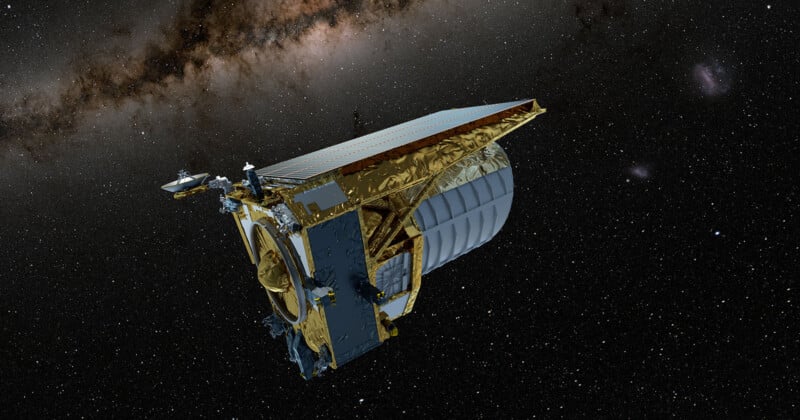
After more than a decade of work by over 2,000 scientists from 300 institutes around the world, the European Space Agency (ESA) is mere hours away from launching its new space probe, Euclid, from Cape Canaveral, Florida.
Euclid Launches Tomorrow to Begin its Journey to L2
At 11:11 a.m. EDT, a SpaceX Falcon 9 rocket will launch Euclid into space, taking the spacecraft on a nearly one-million-mile journey to the second Lagrangian point (L2). The location is an ideal location for advanced space probes and is where the James Webb Space Telescope is currently in orbit.
While Euclid will share its home with Webb, the two space telescopes are doing very different work. “It’s kind of an anti-JWST,” says Mark McCaughrean, as reported by WIRED. McCaughrean is the ESA’s senior adviser for science and exploration.
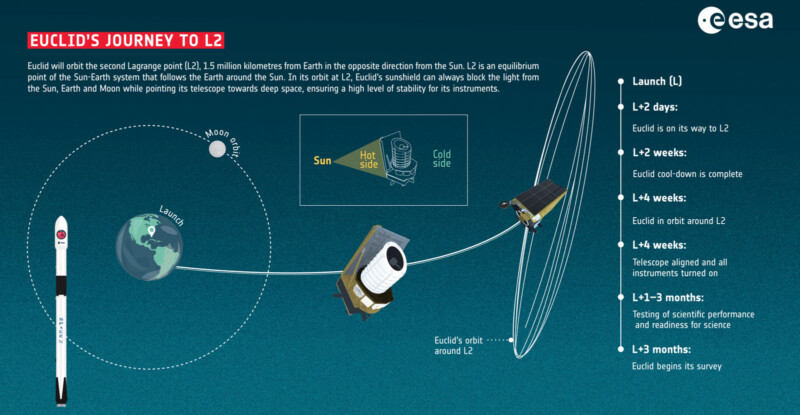
Euclid versus Webb: Two Different Mission Objectives
“Instead of focusing on a very small piece of sky, the whole aim of Euclid is to widen out and look over a huge part of the sky. It’s a statistics mission. The aim is to drown yourself in so much data and so many galaxies, and then you can start teasing out the subtle signals,” adds McCaughrean.
Named after the Greek mathematician Euclid of Alexandria, the Euclid spacecraft aims to explore dark energy and the “evolution of the dark Universe.” Euclid will allow scientists to build a three-dimensional map of the Universe (time is the third dimension) and observe billions of galaxies.
“While dark energy accelerates the expansion of the universe and dark matter governs the growth of cosmic structures, scientists remain unsure about what dark energy and dark matter actually are. By observing the universe evolving over the past 10 billion years, Euclid will reveal how it has expanded and how structure has formed over cosmic history — and from this, astronomers can infer the properties of dark energy, dark matter, and gravity, to reveal more about their precise nature,” the ESA explains.

Unraveling the Cosmic Web
Euclid aims to investigate some of the most important issues in cosmology, including the structure and history of the cosmic web, the nature of dark matter, the expansion of the universe, the nature of dark energy, and whether humanity’s understanding of gravity is complete.
Dark matter and dark energy remain some of the most puzzling aspects of the universe. Scientists believe that dark matter uses gravity to pull cosmological stuff together, while the even more mysterious dark energy seems to be pushing things apart and accelerating the universe’s expansion, a landmark discovery made in 1998.
Current estimates suggest that about 68 percent of the universe is dark energy, while 27 percent is dark matter. The remaining five percent is everything else. While taking “everything else” for granted may be easy, that five percent contains everything on Earth and everything that has ever been observed.
Learning more about the staggering 95 percent of the universe that people know next to nothing about is a key objective for Euclid. However, investigating dark matter and dark energy is remarkably challenging, hence why so little is known.
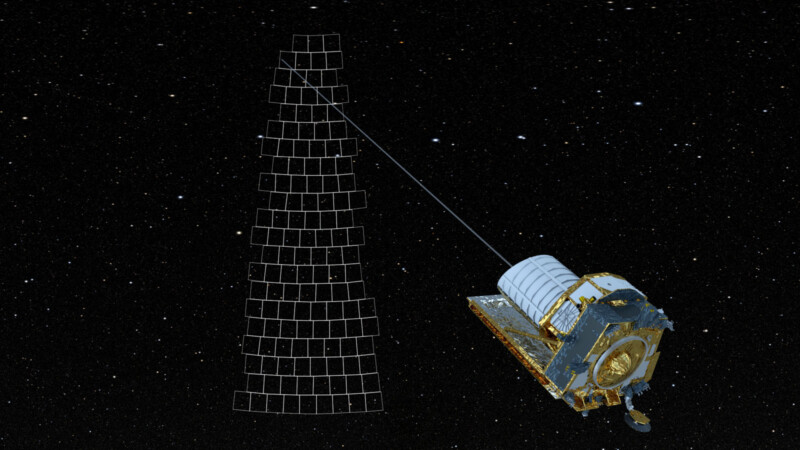
“Dark matter is something that gravity works on in the same way as normal matter, but it doesn’t interact with any light or any anything so we only know it’s there by the effect it has on the movements of galaxies and stars,” Isobel Hook, a professor of astrophysics at Lancaster University in the U.K. and a Euclid scientist, tells Space.com. “Whereas dark energy is something we found out about more recently when we discovered that the expansion of the universe seems to be getting faster with time. That doesn’t make any sense if you think there’s just gravity there. It should be slowing down.”
Euclid will try to bring the invisible universe into the light by looking deep into the cosmos, peering 10 billion years into the past, and mapping the distribution of galaxies outside the Milky Way galaxy. Euclid will map about one-third of the sky, which will take about six years.
Using Gravitional Lensing to Measure Invisible Matter
Euclid will rely upon gravitational lensing. These distortions, which are far too minor to be observed from Earth, result from large amounts of matter bending light rays.
“Gravitational lensing occurs when a massive celestial body — such as a galaxy cluster — causes a sufficient curvature of spacetime for the path of light around it to be visibly bent, as if by a lens. The body causing the light to curve is accordingly called a gravitational lens,” explains the Hubble team.
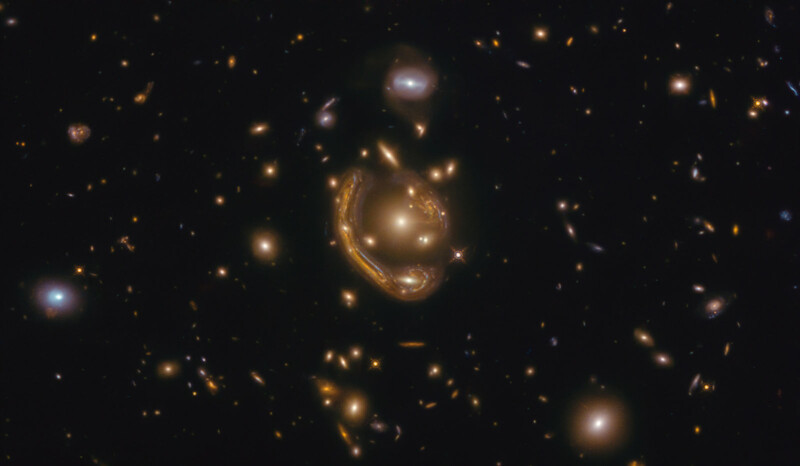
Measuring gravitational lensing is not new — scientists use images from Hubble and Webb to estimate the possible amount of dark matter in certain areas — but the effect is so small that any improvement to instrument accuracy has a considerable benefit to the scientific study of the dark universe.

“The effect is very tiny, less than one percent,” Giuseppe Racca, Euclid project manager at the ESA, explains to Space.com. “To detect this tiny effect is very difficult. We need to be very, very precise with our image quality and measure many, many galaxies to be able to deduce anything.”
“By using some rather complicated math, astronomers will be able to use these gravitational lensing measurements to calculate the amount of dark matter between Euclid and each distorted galaxy, allowing them to create the first-ever 3D map of the dark matter’s distribution in the universe,” explains Space.com.
The Mysteries of Dark Energy
While scientists are confident that dark matter exists — although it has only ever been inferred through its gravitational effect on visible matter – the nature of dark energy is much less understood. The discovery of dark energy was recognized in 2011, so it is a remarkably young concept.
Scientists are optimistic that Euclid will create some massive surprises. While Einstein’s general theory of relativity is considered by many to be established science, it remains an open question whether general relativity applies at a cosmological scale. Euclid could provide further evidence of Einstein’s theory or may upset it entirely.
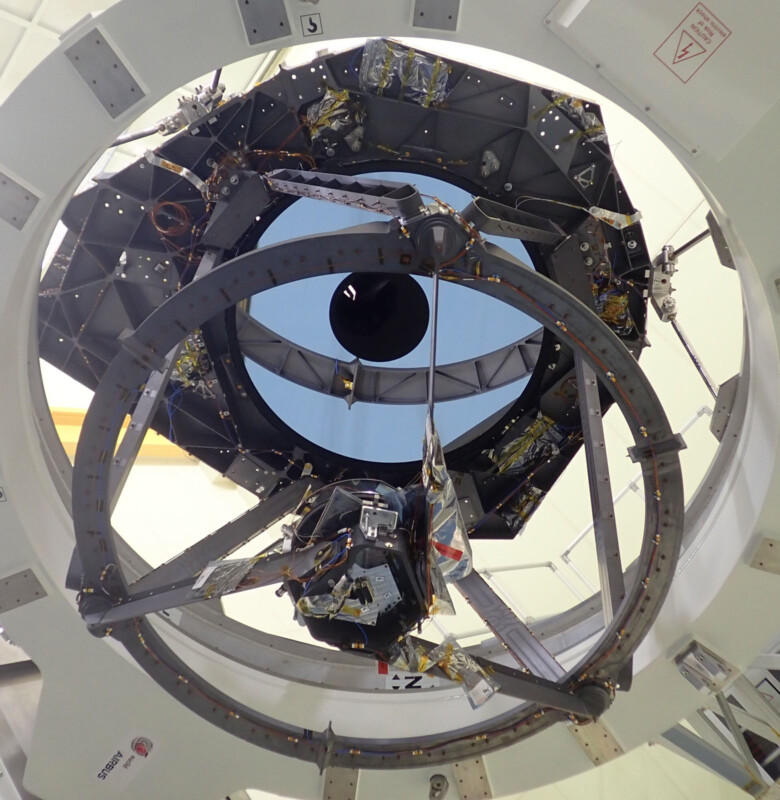
Euclid’s Eyes — Spacecraft Features Incredible Instruments
There are two scientific instruments on the Euclid spacecraft, which is approximately 4.7 meters tall and 3.7 meters in diameter.
One is a visible-wavelength camera, called the VISible instrument, or VIS. The other is a near-infrared camera/spectrometer called the Near-Infrared Spectrometer and Photometer, or NISP.
“The VIS instrument will image a large swathe of the distant Universe with almost the fine resolution of the Hubble Space Telescope, observing more of the Universe in one day than Hubble did in 25 years,” explains Professor Mark Cropper, the lead of the VIS camera team, in reporting by Daily Mail.
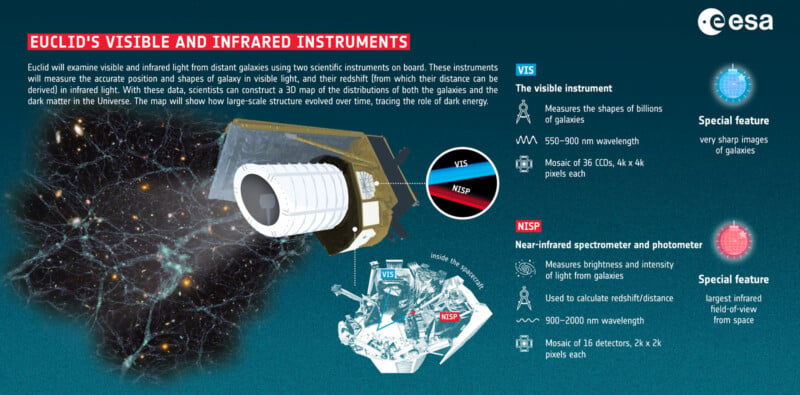
While VIS’s wide field of view will not deliver images as sharp as Hubble’s, it can see a much more expansive part of the sky.
“Each image would require 300 high-definition TV screens to display, and will allow the shape of more than 1.5 billion galaxies to be measured,” writes Daily Mail. Professor Cropper adds that the images are “huge” and “unprecedented.”
The NISP instrument is led by scientists in France and will measure the distance between galaxies, which will help scientists measure the universe’s rate of expansion.
“This is a very exciting time for astronomy, and cosmology in particular,” says Professor Andy Taylor from the University of Edinburgh. Taylor leads the gravitational lensing data analysis for Euclid.
These two instruments are on the spacecraft’s payload module. There is also a service module, where satellite systems, power generation systems, altitude control, data processing controls, propulsion, telemetry, thermal control, and propulsion systems live.
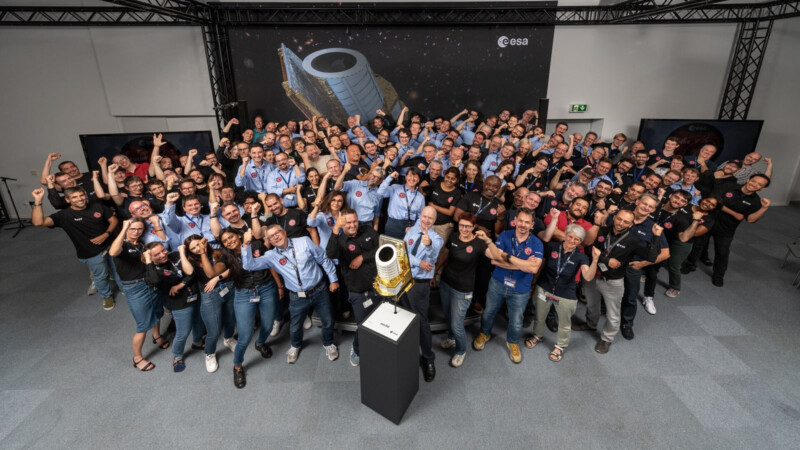
When Will the First Images Arrive on Earth?
The $660 million Euclid spacecraft will reveal its first views of the cosmos within a few months. However, the critical data the team seeks will take years to collect and analyze.
“Who knows what new discoveries await us?” asks Professor Adam Amara, director of the University of Portsmouth’s Institute of Cosmology and Gravitation.
“Maybe we will have a surprise. I just can’t wait to find out,” exclaims Hook.